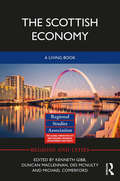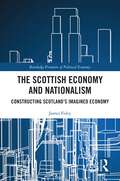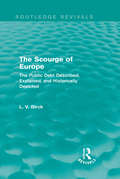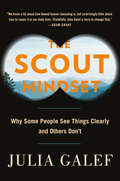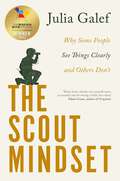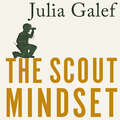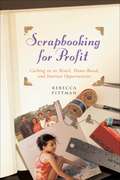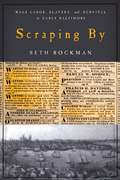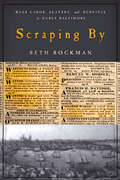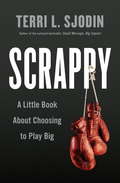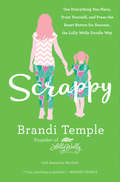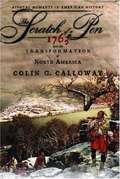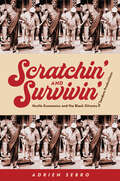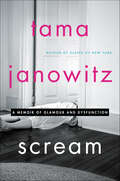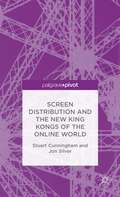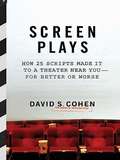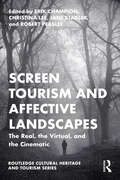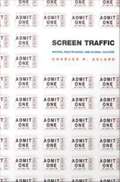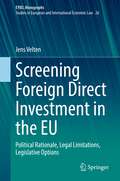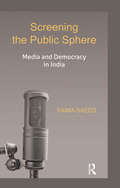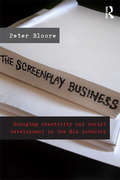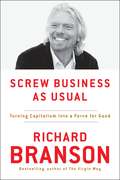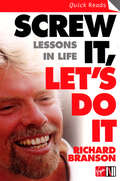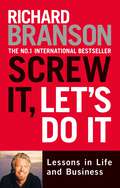- Table View
- List View
The Scottish Economy: A Living Book (Regions and Cities)
by Duncan Maclennan Kenneth Gibb Des Mcnulty Michael ComerfordThe Scottish economy is at the heart of contemporary constitutional and public policy debates. This substantial new edited collection, the first comprehensive and authoritative analysis for more than 60 years, is a timely update on the classic volume of the same name edited by Sir Alec Cairncross in 1954. It is data rich, and offers links to updatable data and leading indicators of the Scottish economy including measures of public finances, distributional evidence and growth. Readers will find a series of easy to follow chapters covering the Scottish economy from every angle – oil and gas, health, education, finance, rural Scotland, inequality, climate change, gender and work, housing, infrastructure and cities. Each sector-based chapter explores the main issues, draws out key empirical facts and considers policy challenges that lie ahead. This book includes: an historical account of the development of the Scottish economy; the trajectory of economic policy in Scotland; reviews of the current fiscal position and the wider economic landscape; and also an intriguing insight into the emerging distinctive approach to Scottish public policy. This book brings together evidence and high quality research by experts on the Scottish economy in a politically neutral, accessible and non-technical way. The volume will assist readers in navigating their way through the many political debates about constitutional and economic futures that are underway in modern Scotland and the UK.
The Scottish Economy and Nationalism: Constructing Scotland’s Imagined Economy (Routledge Frontiers of Political Economy)
by James FoleyScotland’s economic capacity to prosper independently of Britain has become a key political issue, dominating the independence referendum of 2014 and continuing to influence British politics since. But, as this book shows, the Scottish economy, is not merely a statistical object – it is also a political, sociological and cultural idea which has been imagined and constructed. The book explores the history of how Scotland has been framed in statistical and policy terms which are laden with conflicts over meaning, ranging from class struggles and struggles against "external control" to the ongoing debate over national independence. Using Scotland as a case study for examining the political meaning of "the economy", the book also considers the origins of efforts to measure the Scottish economy in the British nationalist terms of "regional policy". It then considers the influence, in turn, of North Sea oil, globalisation/Europeanisation, class dealignment and neoliberal "enterprise" ideology in changing the meanings attached to the Scottish economy. These form necessary conditions for the debate on national independence, where the nature and the future of the Scottish economy remains the central controversy. By examining the economic ideas of a self-proclaimed "cosmopolitan" nationalist movement, the study will offer deeper insights into how nationalists are adapting to the crisis of globalisation. This book marks a significant contribution to the literature on Scottish independence as well as economic sociology, nationalism, critical geography and political economy more broadly.
The Scourge of Europe: The Public Debt Described, Explained, and Historically Depicted (Routledge Revivals)
by L. V. BirckWritten during the early 1920s, at a time when Europe was still recovering from the catastrophe of the First World War, L.V. Birck’s The Scourge of Europe examines the economic issues surrounding the existence of public debt, its history, and possible approaches to problems associated with public debt as they were being pursued by the great powers of the time. Birck’s analysis contains a rigorous theoretical exposition and explanation of public debt as it was understood in the crucial period leading up to the Great Depression. This is then followed by an insightful exploration of the role of public debt in European financial and economic history. Finally, some reflections on the policies of England, the United States, France and Germany in the latter part of the nineteenth and early-twentieth centuries are included. This book will appeal to economic and financial historians, as well as to those generally interested in European policies towards debt from the Middle Ages to modern times.
The Scout Mindset: Why Some People See Things Clearly and Others Don't
by Julia GalefA better way to combat knee-jerk biases and make smarter decisions, from Julia Galef, the acclaimed expert on rational decision-making.When it comes to what we believe, humans see what they want to see. In other words, we have what Julia Galef calls a "soldier" mindset. From tribalism and wishful thinking, to rationalizing in our personal lives and everything in between, we are driven to defend the ideas we most want to believe--and shoot down those we don't. But if we want to get things right more often, argues Galef, we should train ourselves to have a "scout" mindset. Unlike the soldier, a scout's goal isn't to defend one side over the other. It's to go out, survey the territory, and come back with as accurate a map as possible. Regardless of what they hope to be the case, above all, the scout wants to know what's actually true.In The Scout Mindset, Galef shows that what makes scouts better at getting things right isn't that they're smarter or more knowledgeable than everyone else. It's a handful of emotional skills, habits, and ways of looking at the world--which anyone can learn. With fascinating examples ranging from how to survive being stranded in the middle of the ocean, to how Jeff Bezos avoids overconfidence, to how superforecasters outperform CIA operatives, to Reddit threads and modern partisan politics, Galef explores why our brains deceive us and what we can do to change the way we think.
The Scout Mindset: Why Some People See Things Clearly and Others Don't
by Julia GalefWinner of best smart thinking book 2022 (Business Book Awards)Guardian best books of 2021'Original, thought-provoking and a joy to read' Tim Harford'Highly recommended. It's not easy to become (more of) a scout, but it's hard not to be inspired by this book' Rutger BregmanWhen it comes to what we believe, humans see what they want to see. In other words, we have what Julia Galef calls a 'soldier' mindset. From tribalism and wishful thinking, to rationalising in our personal lives and everything in between, we are driven to defend the ideas we most want to believe - and shoot down those we don't.But if we want to get things right more often we should train ourselves to think more like a scout. Unlike the soldier, a scout's goal isn't to defend one side over the other. It's to go out, survey the territory, and come back with as accurate a map as possible. Regardless of what they hope to be the case, above all, the scout wants to know what's actually true.In The Scout Mindset, Galef shows that what makes scouts better at getting things right isn't that they're smarter or more knowledgeable than everyone else. It's a handful of emotional skills, habits, and ways of looking at the world - which anyone can learn. With fascinating examples ranging from how to survive being stranded in the middle of the ocean, to how Jeff Bezos avoids overconfidence, to how superforecasters outperform CIA operatives, to Reddit threads and modern partisan politics, Galef explores why our brains deceive us and what we can do to change the way we think.'With insights that are both sharp and actionable, The Scout Mindset picks up where Predictably Irrational left off. Reading it will teach you to think more clearly, see yourself more accurately, and be wrong a little less often' Adam Grant
The Scout Mindset: Why Some People See Things Clearly and Others Don't
by Julia GalefWinner of best smart thinking book 2022 (Business Book Awards)Guardian best books of 2021'Original, thought-provoking and a joy to read' Tim Harford'Highly recommended. It's not easy to become (more of) a scout, but it's hard not to be inspired by this book' Rutger BregmanWhen it comes to what we believe, humans see what they want to see. In other words, we have what Julia Galef calls a 'soldier' mindset. From tribalism and wishful thinking, to rationalising in our personal lives and everything in between, we are driven to defend the ideas we most want to believe - and shoot down those we don't.But if we want to get things right more often we should train ourselves to think more like a scout. Unlike the soldier, a scout's goal isn't to defend one side over the other. It's to go out, survey the territory, and come back with as accurate a map as possible. Regardless of what they hope to be the case, above all, the scout wants to know what's actually true.In The Scout Mindset, Galef shows that what makes scouts better at getting things right isn't that they're smarter or more knowledgeable than everyone else. It's a handful of emotional skills, habits, and ways of looking at the world - which anyone can learn. With fascinating examples ranging from how to survive being stranded in the middle of the ocean, to how Jeff Bezos avoids overconfidence, to how superforecasters outperform CIA operatives, to Reddit threads and modern partisan politics, Galef explores why our brains deceive us and what we can do to change the way we think.'With insights that are both sharp and actionable, The Scout Mindset picks up where Predictably Irrational left off. Reading it will teach you to think more clearly, see yourself more accurately, and be wrong a little less often' Adam Grant
Scovill, Inc.: NuTone Housing Group
by Lourdes Ferreira Kenneth A. MerchantDescribes a conflict between the corporate controller and a division president about labor standards, which the division purposefully overstates to protect its margins. Illustrates the multiple roles of standards, and the roles of controllers and line management in resolving such conflicts.
Scrapbooking for Profit: Cashing in on Retail, Home-Based, and Internet Opp
by Rebecca F. PittmanThis comprehensive guide reveals 11 paths to making money in the scrapbook market, along with the tools to do it. Every career option, business situation, and topic a scrapbook artist may encounter is covered in clear, calm, step-by-step explanations and short, easy-to-grasp chapters. Quotes, advice, and tips from industry experts; checklists and self-assessment questionnaires; convenient business forms, sample contracts, and planning tools; and amusing illustrations-plus a supportive, you-can-do-it tone-make Scrapbooking for Profit the best friend a scrapbooking entrepreneur can have.
Scraping By: Wage Labor, Slavery, and Survival in Early Baltimore
by Seth RockmanEnslaved mariners, white seamstresses, Irish dockhands, free black domestic servants, and native-born street sweepers all navigated the low-end labor market in post-Revolutionary Baltimore. Seth Rockman considers this diverse workforce, exploring how race, sex, nativity, and legal status determined the economic opportunities and vulnerabilities of working families in the early republic. In the era of Frederick Douglass, Baltimore's distinctive economy featured many slaves who earned wages and white workers who performed backbreaking labor. By focusing his study on this boomtown, Rockman reassesses the roles of race and region and rewrites the history of class and capitalism in the United States during this time. Rockman describes the material experiences of low-wage workers—how they found work, translated labor into food, fuel, and rent, and navigated underground economies and social welfare systems. He also explores what happened if they failed to find work or lost their jobs. Rockman argues that the American working class emerged from the everyday struggles of these low-wage workers. Their labor was indispensable to the early republic’s market revolution, and it was central to the transformation of the United States into the wealthiest society in the Western world. Rockman’s research includes construction site payrolls, employment advertisements, almshouse records, court petitions, and the nation’s first "living wage" campaign. These rich accounts of day laborers and domestic servants illuminate the history of early republic capitalism and its consequences for working families.
Scraping By: Wage Labor, Slavery, and Survival in Early Baltimore (Studies in Early American Economy and Society from the Library Company of Philadelphia)
by Seth RockmanCo-winner, 2010 Merle Curti Award, Organization of American HistoriansWinner, 2010 Philip Taft Labor History Book Award, ILR School at Cornell University and the Labor and Working-Class History AssociationWinner, 2010 H. L. Mitchell Award, Southern Historical AssociationEnslaved mariners, white seamstresses, Irish dockhands, free black domestic servants, and native-born street sweepers all navigated the low-end labor market in post-Revolutionary Baltimore. Seth Rockman considers this diverse workforce, exploring how race, sex, nativity, and legal status determined the economic opportunities and vulnerabilities of working families in the early republic.In the era of Frederick Douglass, Baltimore's distinctive economy featured many slaves who earned wages and white workers who performed backbreaking labor. By focusing his study on this boomtown, Rockman reassesses the roles of race and region and rewrites the history of class and capitalism in the United States during this time. Rockman describes the material experiences of low-wage workers—how they found work, translated labor into food, fuel, and rent, and navigated underground economies and social welfare systems. He also explores what happened if they failed to find work or lost their jobs. Rockman argues that the American working class emerged from the everyday struggles of these low-wage workers. Their labor was indispensable to the early republic’s market revolution, and it was central to the transformation of the United States into the wealthiest society in the Western world. Rockman’s research includes construction site payrolls, employment advertisements, almshouse records, court petitions, and the nation’s first "living wage" campaign. These rich accounts of day laborers and domestic servants illuminate the history of early republic capitalism and its consequences for working families.
Scrappy: A Little Book About Choosing to Play Big
by Terri L. SjodinScrappy \'skra-pē\ adj: Full of fighting spirit--synonymous with having moxie, being feisty, enthusiastic, gutsy, lively,and spunky Maybe you have been told time and time again that if you pay your dues and keep plugging away, you'll gain enough experience through "the school of hardknocks" to be successful. That might be true. But maybe you want to reach your goals faster. Maybe you want to earn more, beat the odds--and do it with class and style. If so, it's time to get scrappy. Scrappy people see big problems and come up with big solutions. Or they see ordinary challenges and find a new path to extraordinary results. They're like the entrepreneur who turned his home into an indoor jungle--complete with waterfalls, tropical birds, and a live baboon--to sell investors on the now famous Rainforest Café restaurant chain. Or the Girl Scout who skipped the usual door-to-door cookie sales and set up a table outside a medical marijuana dispensary, selling 117 boxes in just 2 hours. It can seem like these successes are just one-off acts of ingenuity or isolated flashes of brilliance...but are they? In today's world you need more than just an occasional burst of creativity. You need a consistent attitude, a proven strategy, and a tactical plan for execution. That's where Terri Sjodin's Scrappy can help you, by explaining and demonstrating the unique elements behind any successful scrappy effort. Drawing on research, interviews, and her own personal experience, Sjodin identifies the habits that will help you get into the right mind-set. She shares stories of scrappy tactics that have worked and those that have crashed and burned, in order to provide practical takeaways for achieving your vision, whatever it might be. She explains, for instance... * Why getting scrappy is a choice to play big. * How to cultivate your best ideas. * How to manage risks and bounce back from mistakes and failures. * How to scale a scrappy culture within anyorganization, big or small.As Sjodin puts it, "This is not another book about persistence, although scrappy and persistent make a winning combination. Nothing annoys a persistent person more than a scrappy person who pulls off a classy, unexpected, amazing effort to land the deal, the sale, or the opportunity."Whether you're a sales rep, a job seeker, an entrepreneur with big dreams but a small budget, or a corporate executive aiming for the next level of success, the fastest way to get what you want is to get scrappy. From the Hardcover edition.
Scrappy: Use Everything You Have, Trust Yourself, And Press The Reset Button For Success, The Lolly Wolly Doodle Way
by Brandi TempleBorn from a hobby of sewing clothes for her daughters, Brandi Temple’s Lolly Wolly Doodle has grown into one of the largest online retailers of children’s and family clothing. Brandi’s transition from a full-time mom to selling in flea markets to establishing a wildly successful e-Bay store and Facebook presence to becoming founder and CEO of a successful company was by no means easy, but each hardship only strengthened her resolve. Along the way, Brandi has kept both her faith and family at the forefront, while maintaining the positive attitude she is best known for. A business story layered onto a winning personal narrative, Scrappy is packed with her homespun (and seriously killer smart) philosophy: - Use all the scraps - Press the reset button as many times as you want - Know your customer by meeting her - Always act on an “ah ha” moment
The Scratch of a Pen: 1763 and the Transformation of North America (Pivotal moments in American history)
by Colin G. CallowayIn this superb volume in Oxford's acclaimed Pivotal Moments series, Colin Calloway reveals how the Treaty of Paris of 1763 had a profound effect on American history, setting in motion a cascade of unexpected consequences, as Indians and Europeans, settlers and frontiersmen, all struggled to adapt to new boundaries, new alignments, and new relationships.
Scratchin' and Survivin': Hustle Economics and the Black Sitcoms of Tandem Productions
by Adrien SebroThe 1970s was a golden age for representations of African American life on TV sitcoms: Sanford & Son, Good Times, The Jeffersons. Surprisingly, nearly all the decade’s notable Black sitcoms were made by a single company, Tandem Productions. Founded by two white men, the successful team behind All in the Family, writer Norman Lear and director Bud Yorkin, Tandem gave unprecedented opportunities to Black actors, writers, and producers to break into the television industry. However, these Black auteurs also struggled to get the economic privileges and creative autonomy regularly granted to their white counterparts. Scratchin’ and Survivin’ discovers surprising parallels between the behind-the-scenes drama at Tandem and the plotlines that aired on their sitcoms, as both real and fictional African Americans devised various strategies for getting their fair share out of systems prone to exploiting their labor. The media scholar Adrien Sebro describes these tactics as a form of “hustle economics,” and he pays special attention to the ways that Black women—including actresses like LaWanda Page, Isabel Sanford, and Esther Rolle—had to hustle for recognition. Exploring Tandem’s complex legacy, including its hit racially mixed sitcom Diff’rent Strokes, he showcases the Black talent whose creative agency and labor resilience helped to transform the television industry.
Scream: A Memoir of Glamour and Dysfunction
by Tama JanowitzIn this darkly funny, surprising memoir, the original “Lit Girl” and author of the era-defining Slaves of New York considers her life in and outside of New York City, from the heyday of the 1980s to her life today in a tiny upstate town that proves that fact is always stranger than fiction. With the publication of her acclaimed short story collection Slaves of New York, Tama Janowitz was crowned the Lit Girl of New York. Celebrated in rarified literary and social circles, she was hailed, alongside Mark Lindquist, Bret Easton Ellis, and Jay McInerney, as one of the original “Brat Pack” writers—a wave of young minimalist authors whose wry, urbane sensibility captured the zeitgeist of the time, propelling them to the forefront of American culture.In Scream, her first memoir, Janowitz recalls the quirky literary world of young downtown New York in the go-go 1980s and reflects on her life today far away from the city indelible to her work. As in Slaves of New York and A Certain Age, Janowitz turns a critical eye towards life, this time her own, recounting the vagaries of fame and fortune as a writer devoted to her art. Here, too, is Tama as daughter, wife, and mother, wrestling with aging, loss, and angst, both adolescent (her daughter) and middle aged (her own) as she cares for a mother plagued by dementia, battles a brother who questions her choices, and endures the criticism of a surly teenager.Filled with a very real, very personal cast of characters, Scream is an intimate, scorching memoir rife with the humor, insight, and experience of a writer with a surgeon’s eye for detail, and a skill for cutting straight to the strangest parts of life.
Screen Distribution and the New King Kongs of the Online World
by Stuart Cunningham Jon SilverDrawing on comparisons with historical shake-ups in the film industry, Screen Distribution Post-Hollywood offers a timely account of the changes brought about in global online distribution of film and television by major new players such as Google/YouTube, Apple, Amazon, Yahoo , Facebook, Netflix and Hulu.
Screen Plays: How 25 Scripts Made It to a Theater Near You--for Better or Worse
by David S. CohenIn this fascinating survey of contemporary screen craft, David Cohen of Script and Variety magazines leads readers down the long and harrowing road every screenplay takes from idea to script to screen. In interviews with Hollywood screenwriters from across the board-Oscar winners and novices alike-Cohen explores what sets apart the blockbuster successes from the downright disasters. Tracing the fortunes of twenty-five films, including Troy, Erin Brockovich, Lost in Translation, and The Aviator, Cohen offers insider access to back lots and boardrooms, to studio heads, directors, and to the over-caffeinated screenwriters themselves. As the story of each film evolves from the drawing board to the big screen, Cohen proves that how a script is written, sold, developed, and filmed can be just as dramatic and intriguing as the movie itself-especially when the resulting movie is a fiasco. Covering films of all kinds-from tongue-in-cheek romps like John Waters's A Dirty Shame to Oscar winners like Monster's Ball and The Hours-Screen Plays is an anecdote-filled, often inspiring, always revealing look at the alchemy of the movie business. With Cohen as your expert guide, Screen Plays exposes how and why certain films (such as Gladiator) become "tent poles," those runaway successes every studio needs to survive, and others become train wrecks. Full of critical clues on how to sell a script-and avoid seeing it destroyed before the director calls Action!-it's the one book every aspiring screenwriter will find irresistible.
Screen Tourism and Affective Landscapes: The Real, the Virtual, and the Cinematic (Routledge Cultural Heritage and Tourism Series)
by Erik Champion Christina Lee Jane Stadler Robert Moses PeasleeThis book explores ways in which screen-based storyworlds transfix, transform, and transport us imaginatively, physically, and virtually to the places they depict or film. Topics include fantasy quests in computer games, celebrity walking tours, dark tourism sites, Hobbiton as theme park, surf movies, and social gangs of Disneyland. How physical, virtual, and imagined locations create a sense of place through their immediate experience or visitation is undergoing a revolution in technology, travel modes, and tourism behaviour. This edited collection explores the rapidly evolving field of screen tourism and the affective impact of landscape, with provocative questions and investigations of social groups, fan culture, new technology, and the wider changing trends in screen tourism. We provide critical examples of affective landscapes across a wide range of mediums (from the big screen to the small screen) and locations. This book will appeal to students and scholars in film and tourism, as well as geography, design, media and communication studies, game studies, and digital humanities.
Screen Traffic: Movies, Multiplexes, and Global Culture
by Charles R. AclandIn Screen Traffic, Charles R. Acland examines how, since the mid-1980s, the U. S. commercial movie business has altered conceptions of moviegoing both within the industry and among audiences. He shows how studios, in their increasing reliance on revenues from international audiences and from the ancillary markets of television, videotape, DVD, and pay-per-view, have cultivated an understanding of their commodities as mutating global products. Consequently, the cultural practice of moviegoing has changed significantly, as has the place of the cinema in relation to other sites of leisure. Integrating film and cultural theory with close analysis of promotional materials, entertainment news, trade publications, and economic reports, Acland presents an array of evidence for the new understanding of movies and moviegoing that has developed within popular culture and the entertainment industry. In particular, he dissects a key development: the rise of the megaplex, characterized by large auditoriums, plentiful screens, and consumer activities other than film viewing. He traces its genesis from the re-entry of studios into the movie exhibition business in 1986 through 1998, when reports of the economic destabilization of exhibition began to surface, just as the rise of so-called e-cinema signaled another wave of change. Documenting the current tendency toward an accelerated cinema culture, one that appears to arrive simultaneously for everyone, everywhere, Screen Traffic unearths and critiques the corporate and cultural forces contributing to the "felt internationalism" of our global era.
Screening Foreign Direct Investment in the EU: Political Rationale, Legal Limitations, Legislative Options (European Yearbook of International Economic Law #26)
by Jens VeltenForeign Direct Investment (FDI) from third countries—a desirable form of investment to boost the EU’s economy or a threat to important EU and Member State interests that must be mitigated via FDI screening mechanisms? FDI screening is a complex, controversial and highly topical subject at the intersection of law, politics and economics. This book analyzes the political rationale behind FDI screening in the EU, reveals the legal limitations of current FDI screening mechanisms based on security and public order, and identifies legislative options for broader screening mechanisms in accordance with EU and international economic law. In particular, the book identifies the four main concerns in the EU regarding FDI from third countries: distortive competition effects; the lack of reciprocity on FDI treatment between the EU and the investor’s home country; objectives of the investor or their home country that may be detrimental to EU interests; and safety of private information. On this basis, the book analyzes the Screening Regulation (Regulation (EU) 2019/452) and its newly introduced screening ground “security or public order” and asks whether this and other similar screening grounds based on the notions of security, public order and public policy can address these concerns with regard to foreign investors. Based on an analysis of WTO law and EU primary law, it argues that they cannot. Thus, the question arises: Do the EU and Member States have the flexibility to adopt broader FDI screening mechanisms? To answer this question, the book examines the freedoms of capital movement and establishment in EU primary law, as well as various sources of international economic law such as, first and foremost, the WTO’s General Agreement on Trade in Services, but also other bi- and plurilateral trade and investment treaties, including the EU-China Comprehensive Agreement on Investment. In closing, the book identifies various legislative options for broader FDI screening mechanisms—and their shortcomings.
Screening the Public Sphere: Media and Democracy in India
by Saima SaeedFor centuries, democracy and development have steered the imagination of governments, citizens, intelligentsia and policymakers alike. Democracy without free media is a contradiction, while development without democracy is futile. Highlighting the power and significance of contemporary media, this book deconstructs news and news-making on Indian television. In exploring the concepts of ‘sense-making’ and ‘meaning-generation’, it examines how news and the dissemination of information and opinion influence the public sphere, participatory democracy, citizenship and civil society. Providing an original interpretation of the paradigmatic shifts in news content and newsroom practices, this book focuses on changing ownership patterns, increasing ‘entertainmentalization’ of news and the resultant ‘developmental reportage deficit’. At the same time, it confronts the uneasy and critical consequences of commercialization and rising sensationalism in news media. Finally, it discusses the role of Public Service Broadcasting, journalistic ethics, objectivity, and the politics of language and ideology in the media today, pointing to the need for greater diversity of content on the one hand and an emphasis on public interest in media policy-making, on the other. Drawing upon comprehensive empirical data, the democracy–media–development relationship is demonstrated through critical analyses of the media’s coverage of recent news events. This includes exhaustive content examination of news programmes on all major news channels of India, surveys with media experts and news professionals by way of questionnaires, and interviews with the audience to gauge the impact of media content on their understanding of social, political and economic issues. This volume will be especially useful to those in journalism, media and communication studies, as also to students of political science, sociology and economics.
The Screenplay Business: Managing Creativity and Script Development in the Film Industry
by Peter BlooreThe development of a film screenplay is a complex and collaborative process, beginning with an initial story and continuing through drafting and financing to the start of the shoot. And yet the best ways of understanding and managing this process have never been properly studied. The Screenplay Business is the first book to do exactly that, addressing such questions as: How do film scripts get written, and what are the tensions between creativity and business? How can the team of the writer, producer, director and development executive work together most effectively? The Screenplay Business presents a theoretical and practical framework for understanding the business of independent script development, and encompasses ideas about creativity, motivation, managing creative people, value chains, and MBA leadership theories. This book will help producers and writers to nurture their stories through the long development process to the screen. It explains the international film business, and contains new research and extensive interviews with leading industry figures, including practical advice on how to run script meetings and handle notes; how to build a sustainable business; and how to understand what really happens when a script is written. The Screenplay Business is a new key text for academics and students researching film and media, and indispensable reading for anyone working in film screenplay development today.
Screw Business As Usual
by Richard BransonRICHARD BRANSON, one of the world's most famous and admired business leaders, argues that it's time to turn capitalism upside down-to shift our values from an exclusive focus on profit to also caring for people, communities and the planet As he writes: "It's a vibrant and definite sea change from the way business was always done, when financial profit was a driving force. Today, people aren't afraid to say, Screw business as usual!-and show they mean it. "It's amazing how I keep coming across the same message, from bustling global cities to the townships of South Africa to small villages in India to G8 climate conferences. "It's no coincidence that so many people are talking about the same thing. There's a real buzz in the air. Change is happening. "People often associate me with challenges, with trying to break records while sailing the Atlantic or flying in a jet stream in a balloon or going into space with Virgin Galactic. But this book isn't just about fun and adventure and exceeding one's wildest dreams. It's a different kind of business book. It's about revolution. My message is a simple one: business as usual isn't working. In fact, business as usual is wrecking this planet. Resources are being used up; the air, the sea, the land are all heavily polluted. The poor are getting poorer. Many are dying of starvation or because they can't afford a dollar a day for lifesaving medicine. "But my message is not all doom and gloom. I will describe how I think business can help fix things and create a more prosperous world for everyone. I happen to believe in business because I believe that business is a force for good. By that I mean that doing good is good for business. "
Screw It, Let's Do It: Lessons In Life
by Richard BransonThroughout my life I have achieved many remarkable things. In Screw It, Let's Do It, I will share with you my ideas and the secrets of my success, but not simply because I hope they'll help you achieve your individual goals. Today we are increasingly aware of the effects of our actions on the environment, and I strongly believe that we each have a responsibility, as individuals and organisations, to do no harm. I will draw on Gaia Capitalism to explain why we need to take stock of how we may be damaging the environment, and why it is up to big companies like Virgin to lead the way in a more holistic approach to business. In Screw It, Let's Do It I'll be looking forwards to the future. A lot has changed since I founded Virgin in 1968, and I'll explain how I intend to take my business and my ideas to the next level and the new and exciting areas - such as launching Virgin Fuels - into which Virgin is currently moving. But I have also brought together all the important lessons, good advice and inspirational adages that have helped me along the road to success. Ironically, I have never been one to do things by the book, but I have been inspired and influenced by many remarkable people. I hope that you too might find a little inspiration between these pages.
Screw It, Let's Do It: Lessons in Life and Business
by Richard BransonRichard Branson is an iconic businessman. In Screw It, Let's Do It, he shares the secrets of his success and the invaluable lessons he has learned over the course of his remarkable career. As the world struggles with the twin problems of global recession and climate change, Richard explains why it is up to big companies like Virgin to lead the way in finding a more holistic and environmentally friendly approach to business. He also looks to the future and shares his plans for taking his business and his ideas to the next level.Richard reveals the new and exciting areas into which Virgin is currently moving, including biofuels and space travel, and brings together all the important lessons, good advice and inspirational adages that have helped him along the road to success. This is a fantastic motivational business book that will help every reader achieve their own dreams.
